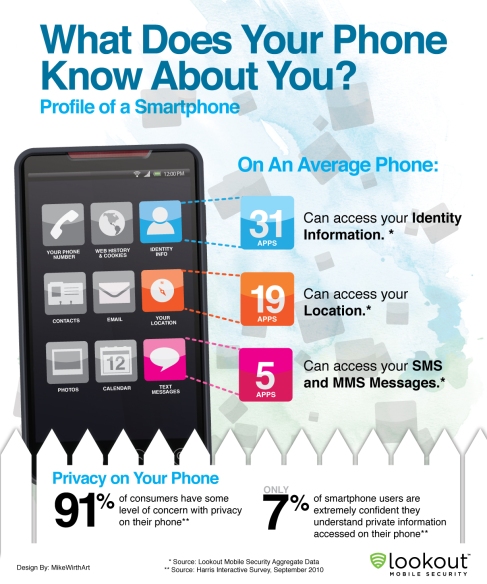Don’t believe me that your smartphone is telling retailers, mortgage brokers, friends, neighbors and that creepy co-worker about where you went to dinner last night and how often you leave the country? I don’t mean to freak you out, but yes, this post offers you the invitation to start to view your precious little iPhone/Android as your potential worst nightmare. Check out this infographic:

Ahh! Do all apps do this?
Not all apps provide the company with your personal information, but the majority do. Most apps offer you the opportunity to allow or deny access your personal information, but some do not. Go to your settings to edit your security preferences, or consider deleting an app without security options.
Did you know, the average person has 41 apps downloaded to his/her smartphone, according to a Nielsen Report featured on thenextweb.com? On average, as you can see above, 31 of these apps can access your identity information, 19 can access your location information, and 5 can access your text messages. And, as you can see 91% of people are at least mildly concerned about this.
Sure, apps can be helpful little tools for creatively waking us up in the morning, making our pictures look like photo booth reels, playing only our favorite music, navigating us to our destinations, organizing our meetings, sending 10-second picture texts to our friends, helping us shop, tracking our workouts, entertaining us with games, and tracking some of our most personal information like calorie intake and menstrual cycles, but what do these apps know about you? The question for you is: Which is more important to me, privacy or some functionality? It’s really up to you.
Why do marketers want this information?
I am a marketer, so let me explain, because it’s actually an earth-shattering innovation when seeking to segment a market! Marketers generally get a higher return on investment when sending a marketing message to an individual most like their typical customer. And, if they have multiple types of customers, the more they know about you, the more relevant the message they send you will be. For example, when I was working for the YMCA, we segmented our market to Seniors, Adults and Families. With Seniors, our messages revolved around enjoying life, taking care of yourself and making friends. With adults, our messages were about meeting your fitness goals. With families, our messages were about spending time together, living a healthy lifestyle, building confidence and making memories together. The more information I have about someone, the better I’ll know if they’re worth spending my money to try to attract to my company and the better appeal my message to them will have.
But, what if I’m a consumer? Is this good news or bad news?
It can be both. If you are seeking a deal, or you are interested in knowing about the latest, greatest product, service or event in your area, keep your eyes out because the messages you receive will become increasingly more appealing over the years as you produce more online data through posts, web searches, online purchases and location check-ins because more data will be available to marketers about who you are and what you’ll likely want to buy.
Now, on the downside, you may be categorized incorrectly with a group of individuals not especially like you. Researchers call this “aggregate data,” but the New York Times rightly identifies it as a type of “stereotyping.” For example, if you like running or only drink red wine on Saturdays, there are a whole slew of consumers with those similar interests, some exactly like you, others extremely different from you. Just hope that their financial behaviors are similar to yours, or you’ll be incorrectly profiled. This New York Times Article explains how aggregate data works with mortgage companies, for example. Based on individuals’ names, addresses, demographics, and online/offline purchasing data, companies identify and categorize customers (according to Lesson 9). This customer profiling is very common in both the marketing and the lending world, and in the business world at large, meanwhile, unbeknownst to you, your app usage, personal interests or web searches might determine whether or not you get approved for a loan (depending on if you fit the profile for a typical high-risk-for-default customers). Here’s another infographicyou might find interesting:

Where do companies get this information?
There are companies called “Data Aggregators” that specialize in pulling together data for marketers to use. One of the largest data aggregators in existence is called Spokeo. This site is pretty interesting because you can actually look up information on people, including searching those annoying telemarketers’ phone numbers and registering a complaint! On the other hand, if you look up your number, you can most likely pay only 95 cents to see your full name, address, email address, month/year of birth, location history, and relatives. Does that freak you out? It freaked me out when I looked up my husband’s phone number!
In addition to data aggregators, there are about 10 major web analytics companies that businesses can hire to help them track the success of their website and capture website visitor data for future marketing purposes. According to eWeek’s Enterprise Applications: 10 Hot Data, Web Analytics Companies That You Should Know:
- Woopra: This company tracks 200,000 websites for its clients and provides information for them to interact with and engage site visitors.
- Google Analytics: This is a free service used by about 57% of the top 10,000 websites to identify how people find their website, what pages they click, where they’re located, etc.
- Kontagent: This company specializes in viral and social network analysis.
- Flurry: Smartphone owners, here’s your winner. Flurry works with more than 60,000 companies in over 150,000 apps to capture data from your “iOS, Android, Blackberry, windows phone, JavaME, and HTML5 platforms.”
- Radian6: This company specializes in social media engagement and measurement tools, so companies can better use social media channels to communicate brand messages.
- Open Web Analytics: This open-sourced system enables companies to use multiple web analytics softwares simultaneously.
- Piwik: This international web analytics team works on over 250,000 websites in over 45 languages and is constantly releasing new versions of the software that grabs the data.
- Optimizely: This company specializes in helping businesses lay out their website using graphics that are most likely to appeal to consumers.
- HitTail: This company helps businesses see what search terms people are typing into search engines in order to help businesses put those words into their websites for SEO.
- Metricly: This is a one-stop shop for companies to pull graphs, data, financial data, etc. on internet users and a company’s website visitors.
These analysts are mostly for computer-use analytics, but don’t be confused. Check out all the data they can pull from your smartphone:

So what’s the bottom line?
For marketers: LEVERAGE THIS INFORMATION! But use your conscience and, please, don’t exploit people. You’re a consumer, too, and you know your personal information is precious.
For consumers: I recommend two things:
- Don’t fret what marketers know. They are legally required to allow you to “opt out” / “unsubscribe” or be asked to be put in the “do not call” list (which you can actually do on Spokeo on your own.) So, they can’t bother you forever, or they can get HUGE fines.
- Try to increase the security settings on your phone, tablet and computer for the sake of personal privacy. This includes turning off the “location” settings on your apps and your camera and deleting any apps you cannot set the security settings for.
Fascinating stuff, isn’t it? What are your thoughts? Does this freak you out, or were you aware of this before?














